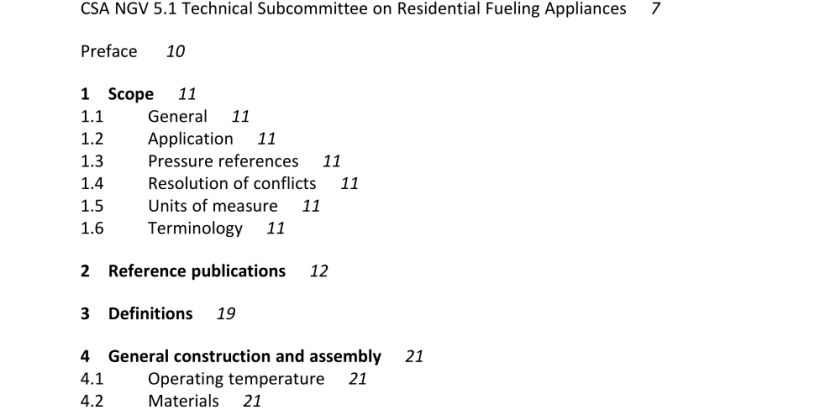ANSI CSA NGV 5.1-2016 pdf download.Residential fueling appliances
3 Definitions
The following definitions shall apply in this Standard: Appliance, fueling — a self-contained assembly or facility used for compression and delivery of natural gas into vehicles with its associated equipment and piping. Automatic restart — a system designed to initiate a fueling sequence without a physical action by a person at the appliance. Blowdown system — an integral component system of the RFA designed to reduce the delivery side pressure (up to and including the fueling nozzle and the space between the vehicle receptacle and check valve) from operating level to 517 kPa (75 psig) or less at the end of every fueling cycle. Note: This allows for safe and easy disconnection ofthe refueling hose from the vehicle by the RFA user. The system may also depressurize the compressor to allow easier starting. The system includes means to contain the expanded volume ofhigh pressure gas necessary to achieve the pressure reduction. British thermal unit (Btu) — the quantity of heat required to raise the temperature of one pound (lb) of water one Fahrenheit (F) degree. Container — a pressure vessel designed to store CNG in accordance with the applicable standards and Code. Cubic foot (CF) — the amount of gas that would occupy one cubic foot at standard conditions. Declared maximum ambient temperature rating (DMATR) — the allowable maximum ambient temperature during operation, as declared by the manufacturer.
Connection — a diagram that shows the connections of an installation or its component devices or parts; it may cover internal or external connections, or both, and contains such detail as is needed to make or trace connections that are involved. The connection diagram usually shows general physical arrangement of the component devices or parts. Schematic — a diagram that shows, by means of graphic symbols, the electrical connections and functions of a specific circuit arrangement. The schematic diagram facilitates tracing the circuit and its functions without regard to the actual physical size, shape, or location of the component devices or parts. Ladder form of schematic — a diagram in the form of a vertical ladder. The outer vertical lines represent the electrical supply conductors. The horizontal steps represent each individual circuit with all component devices. Filter — component containing a screen or media that is intended to remove foreign debris from the gas stream. Gas containment system — a volume integral to the RFA to hold gas during the compression and/or delivery functions of the RFA. Hazard — a condition in which there is a possibility of having a flammable or explosive atmosphere Heating value, higher (HHV) — the number of British Thermal Units produced by the combustion at a constant pressure of one cubic foot of gas.
Listed — equipment or materials included in a list published by a recognized testing laboratory, inspection agency, or other organization concerned with product evaluation (1) that maintains periodic inspection of production of listed equipment or materials, and (2) whose listing states either that the equipment or material meets recognized standards or has been tested and found suitable for use in a specified manner. Manual procedure to restart — initiation of a fueling sequence requires a physical action by a person at the appliance. Natural gas — mixtures of hydrocarbon gases and vapors consisting principally of methane (CH4) in gaseous form. Natural gas, compressed — natural gas that has been compressed for use as a vehicular fuel. Ncc (normal cubic centimeter) — dry gas that occupies a volume of 1 cm 3 at a temperature of 273.15 K (0 ºC) and an absolute pressure of 101.325 kPa (1 atm). Non-hazardous condition — a condition in which there is no possibility of having a flammable or explosive atmosphere. Orifice — the opening in a part or component that limits flow by physical dimensions of the opening. Piping — as used in this requirement, either pipe or tubing, or both.ANSI CSA NGV 5.1-2016 pdf download
